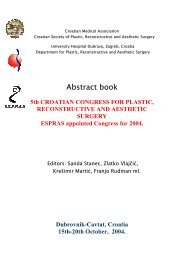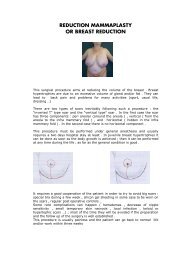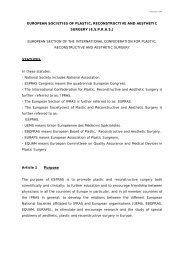Abstract book - ESPRAS
Abstract book - ESPRAS
Abstract book - ESPRAS
You also want an ePaper? Increase the reach of your titles
YUMPU automatically turns print PDFs into web optimized ePapers that Google loves.
25.8% of them had various types of wound healing problems like infection,<br />
detachment, partial or total necrosis. Majority of these patients had diabetes<br />
or high tension electric burn injury.<br />
Conclusion<br />
Vascular anatomy and etiopathology behind the defect should be very well<br />
known in the reconstructive approach to the lower extremity wounds in order<br />
to make a better decision and planning before the closure. Besides, expertise<br />
on local flap use and skills in microsurgical technique will definitely lower<br />
the complication and amputation rates in difficult cases of lower extremity.<br />
H7. Lymphatic reconstruction as a new concept in lymphoedema<br />
surgical treatment<br />
Stritar A., Leskovsek A., Solinc M., Beslic N.<br />
Department for Plastic, Reconstructive Surgery and Burns, Clinical Center,<br />
Ljubljana, Slovenia<br />
In the last decade some new surgical methods for restoration of lymph flow<br />
are described. Some are in experimental research and few are clinically used.<br />
They represent a vascular implantation of a healthy, new lymphatic tissue<br />
into lymphoedematous limb, what it means an inner incorporated flap, as a<br />
conduit for lymph drainage. Reconstruction itself is more complex and<br />
demanding, as bridging or shunting operations, where free omentum, free<br />
lymph perinodal - node and vascularised lymphatico adipovenous flaps are<br />
used.<br />
All the methods must be individually selected to lymphoscintigraphic<br />
findings, local tissue conditions, axioms of lymphoedema surgery and<br />
general condition and aim of a patient. In general, the results of lymphatic<br />
reconstruction operations are still badly evaluated and our experiences and<br />
conclusions are positioned. Theoretical considerations are sometimes<br />
discordant to practical surgical skills and abilities.<br />
We operated 6 patients, as a microsurgical transfer of a lymph node and 2<br />
patients as a bridged omentum major flap, while some patients are recruited<br />
for lymphaticoadipovenous transfer, for secondary lymphoedema.<br />
Results of a lymph node transfer are not finally completed. Our experiences<br />
point out, that surgical release of a scar was in benefit, and healthy lymph<br />
nodes must be selected. According to this fact in a case of lymphatic<br />
systemic predisposition a donor area must be examined by a<br />
lymphoscintigraphic or ultrasound findings.<br />
All mentioned operations above also need more ethical and forensic consent.







